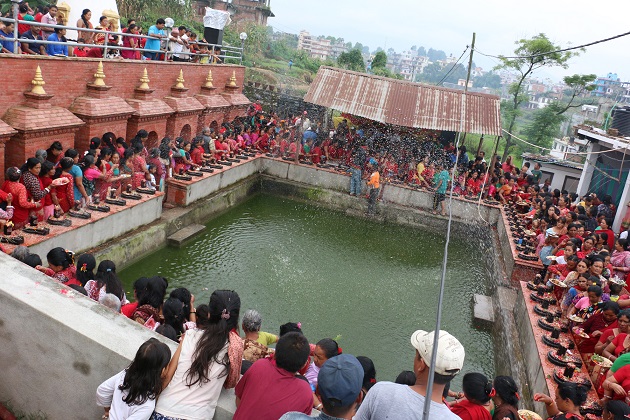‘White Horse’ festival observed in Bhaktapur

Bhadgaon / Oct 25: The customary Seto Ghoda Jatra or the White Horse Festival was observed here on Tuesday, the day of the Bijaya Dashami, the last day of the Bada Dashain, the biggest festival of Nepalis. The white horse is the vehicle of Goddess Taleju Bhawani.
There is the practice of organizing this historical and traditional White Horse festival during the night on the occasion of the Bijaya Dashami and the day after.
Before the start of the jatra or the religious and cultural procession, the four main naikes, achajus, joshis and rajopadhyayas solemnize the kalaratri, tika sait and the bisharjan puja rituals to the Goddess Taleju as per the tantric traditions. The naikes, achajus, joshis and rajopadhyayas are the chief priests, priests, assistants and the attendants who are responsible for performing the customary rituals and associated activities at the Goddess Taleju Temple.
After performing these rituals, the white horse is offered worship and a ram is sacrificed. Then the horse is taken around the ancient Bhaktapur town in a procession, said Siddhibir Karmacharya, the priest at Taleju Temple.
The specially-annointed white horse is taken out from the main square in front of the local Taleju Temple on completion of all rituals and is driven through Khauma, Itanchhe, Bharwacho, Banshagopal, Bhujikokha, Narayanchok in the lower part of the Durbar area and also through Khichhen, Chichhen, Bholachhen, Thalachhen, Dattatraya, Golmadhi, Sukuldhoka, Tamari and Narayanchok in the upper area of the Durbar area in Bhaktapur’s the ancient town.
Similarly, the Payahdyo (Khadga Dev) traditional festival observed in Taleju of Bhaktapur was marked yesterday. This ritual is marked at midnight on the occasion of Bada Dashain and the next day.
As part of this time-honored ritual, the Payahdyo, considered as the true form of Goddess Taleju, is wrapped in a red cloth and made to put on the battle shield.
After performing the due tantric rituals and anointment, the Rajopadhyaya priest of the Taleju Temple carries the Payahdyo on his shoulder from the Taleju main square and carries the deity-incarnate from the Taleju Mulchok (Main Square) up to Bekochok. Upon reaching Bekochok, the public are allowed to offer worship and have a glimpse of the deity.
After reaching the Swarna Dwar or the Golden Gate at the Durbar square, the Payahdyo carries out the ritual of whispering the ‘divine hymn’ into the ear of the Devagana who are waiting for him in a formation turn by turn. Upon completion of this ritual, the Payahdyo, the living deity, march ahead along with the Nawadurga Devaganas, accompanied by a procession.RSS
